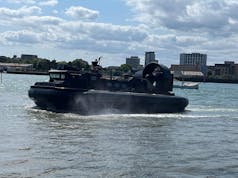HMS Lancaster, a Royal Navy Type 23 frigate, recently conducted a live gunnery exercise to maintain its operational readiness and ensure the crew’s combat skills remain sharp, according to a tweet from the vessel’s official account.
The exercise, which involved the ship’s 4.5-inch Mark 8 naval gun, was part of routine drills designed to test both the crew and equipment in realistic combat scenarios.
The tweet highlighted the importance of these exercises, listing key objectives such as “maintaining readiness,” “honing the skills,” and “staying sharp.”
Today we exercised our gunnery teams, putting the equipment through its paces🏃♀️
✅Maintaining readiness
✅Honing the skills
✅Staying sharp💥4.5 Engage!#GlobalModernReady pic.twitter.com/ijLDnFE2xf
— HMS Lancaster (@HMSLANCASTER) September 10, 2024
The post concluded with a triumphant “4.5 Engage!” signalling the firing of the main gun, underscoring the ship’s capability to respond quickly and effectively in a combat situation.
The 4.5-inch Mark 8 is a naval gun used by the Royal Navy, designed to engage surface, air, and shore targets. It first entered service in 1972, replacing the older World War II-era 4.5-inch Mark I–V naval guns. The Mark 8 has a longer 55-calibre barrel and is used on destroyers and frigates in the Royal Navy. Developed by Vickers Ltd and the Royal Armament Research and Development Establishment, it emphasised reliability and the ability to fire quickly from a shutdown state, making it effective in missile defence.
The gun system is semi-automatic and incorporates both electrical and hydraulic components, allowing for a reduced crew. While the gun itself is controlled from the operations room, personnel in the gunbay load the ammunition, with the system capable of firing around 25 rounds per minute.
The design prioritised a lower rate of fire in favour of accuracy and readiness, and the gun has a range of up to 27.5 kilometres with high-explosive extended-range ammunition. Early models faced reliability issues, particularly during the Falklands War, but a significant modification in 1998 improved performance, including the replacement of the hydraulic system with an electric one.
The gun’s Mod 1 variant, introduced in the late 1990s, included a new gunhouse with a reduced radar cross-section and an all-electric loading mechanism. The Mark 8 is primarily used for fire support against land and sea targets, though its capacity for anti-aircraft missions is debated. It has been nicknamed the “Kryten gun” by Royal Navy personnel due to its distinctive appearance, similar to the character from the British TV series Red Dwarf.














Stick a pair of 15″ guns on ’em and shout “SHOOT.” 😊
Might it be worth while restoring the AA functions of these 4.5″ guns pronto considering the number of ships with it still in service? It might be very useful for counter drone, missile and aircraft.
How often are big guns used in combat situations?
Would 2 ships ever get into a shooting match akin to a modern version of a broadside war?
I think you have to look at the bigger picture when it comes to Naval Guns. When you say combat in a conventional sense for a ship to ship engagement guns are unlikely I would suggest. However the 4.5 and its replacement can also serve in the NGS role. Also providing illumination. The proverbial shot across the bows. In the late sixties the Navy were reducing the amount of small calibre guns on warships. In the east ships so equipped were engaging small junk type craft in interdiction duties. The larger calibre guns just blew them out of the water. A sledgehammer to crack a nut. The solution was to refit Bofors 40/60s. Basically a WW2 weapon. In the seventies we were refitting Leanders as Exocet and Ikara types with Bofors and Seacat. They were a sort of one trick ponies. So the gun is here to stay for many reasons I think.
Italian 76mm – in Italian, French, Danish ship and US 127mm have downed drones this year. Unfortunately RN have taken out the anti- aircraft capability of this gun so might had to spent Aster missiles.
Not entirely true…
The gun can do AA.
The FCS cannot.
Its system of systems semantics I know…
With a boresight camera in and the EOS tracker auto following an aircraft you see the aircraft in the camera as long as you remove deflections from the system.
But what you cannot do is add in deflections because the fire control electronics doesn’t have that anymore for AA mode. Adding deflections would put the gun pointing ahead of the target and allow for shell time of flight etc.
You would also need to add in the new ballistics for the ER base bleed shell in AA mode. The fuse on the shell will do AA as it has a VT High setting as well as VT Low and DA.
So the ERBB have VT fuze with AA capability and it is a modern round that will last in stocks . If that so i think it will be wise to return the capability to the gun T45 FCS
NGS is the primary role.
Anything else is a nice to have